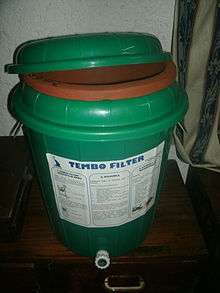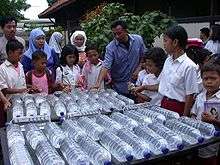Thinking Small: Appropriate Technology for Developing Countries

An appropriate technology is a small-scale, sustainable, and decentralized application of technical innovation. Dr. Ernst Friedrich Schumaker popularized this ideology with his influential book, Small is Beautiful. Appropriate technologies are particularly suited for developing countries because they are environmentally friendly, energy-efficient, and are people-centered instead of machine-centered.
Introduction
One particularly pertinent application for appropriate technologies is supplying plentiful, clean drinking water to developing countries. Although clean water in developed countries is typically supplied by large-scale utility companies, water in developing countries is primarily collected by the end user. [1] Thus, water purification and distribution technology tends to be small and employed at the point of use. Appropriate technologies for water purification are easily maintainable, low-cost, durable, sustainable, environmentally friendly, and intuitive.
Although safe, clean, and plentiful drinking water is a necessity for a healthy life, roughly one in ten people worldwide, or about 663 million people, lack access to safe water. Around the world, every 90 seconds, a child dies from a water-related disease, such as schistosomiasis and cholera. In low and middle income countries, one third of all healthcare facilities lack a safe water source. [2]
The lack of clean drinking water in developing countries is a self-compounding problem that taxes local economies significantly. Due to water-related diseases, the sick and their care-givers are unable to contribute to their community. Healthy citizens waste valuable time hauling clean water over long distances that could instead be spent working to earn income; a vicious cycle results [3].
While there are many viable water purification solutions, choosing a technology that is appropriate for the capabilities of a given community can be complex. Whereas one technology might be suitable from a technical standpoint, it might be an inappropriate fit for the social, cultural, institutional, or economic environment of a community. A study of how appropriate water distribution technologies have been deployed in communities around the world can shed some light on the complexity.
Ceramic Filters
Ceramic Filters purify water by using microscopic pores in the ceramic to strain out microorganisms. While effective at removing bacteria, protozoa, and microbial cysts, they do not remove viruses and chemical pollutants. Silver-impregnated designs kill any lingering bacteria that make it through the filter. Ceramic filters can reduce fecal coliform counts by 99.9% [4] and the incidence of diarrheal diseases by up to 70%. [5]
Potters For Peace (PFP) created a design that is cheap to manufacture and provides up to 20 liters of water per day for 3 years. However, it is not without issues; the filters require regular scrubbing to clear clogged pores and prevent bacterial growth. Replacement parts are needed for breakdowns and the entire system has a lifespan of only a few years; thus, a constant supply of filters is needed to sustain a large community. To this end, PFP established local ceramic filter factories.
After the 2004 Indian Ocean Earthquake and Tsunami, the American Red Cross and the Sri Lanka Red Cross Society provided communities in Sri Lanka with ceramic water filters. Through continued re-visits, the Red Cross staff members explained proper use and care of the filter as well as the importance of general sanitary practices. Bacteria tests confirmed successful implementation of the filters. A few years after the tsunami, local pottery manufacturers began producing replacement ceramic filters, ensuring the system’s longevity. The Red Cross’s attention to the education and training of beneficiaries was crucial to the project’s success. [6]
Slow Sand Filtration
Gravity-driven slow sand filters (SSF) pull water through sand and gravel to filter bacteria and micro-organisms. SSF typically remove 99.98% of protozoa, 90-99% of bacteria, and 80-98% of E. coli. [7].
Samaritan’s Purse has installed SSF in individual households in over 24 countries. However, when outside NGO’s simply provide free technologies to communities, beneficiaries lack a sense of ownership. To combat this, Samaritan’s Purse requires that those interested in receiving a filter must cover part of the initial cost, attend training sessions, and assist with the transportation and construction. Unfortunately, villagers found these requirements to be prohibitive and thus the SSF was not widely adopted. [8]
A research group from the University of Virginia studied a SSF system that had been installed by an outside NGO in a rural Nicaraguan community. Although the system functioned properly when first installed, it had since ceased to deliver its promised results. Through a series of interviews, the team learned that the community had never been taught how the SSF worked or how to properly maintain it. Additionally, the community did not understand the importance of a maintenance budget and making timely system repairs. Because the community lacked the organizational capability to sustain the SSF, they allowed the system to fall into disrepair and eventually opted to bypass the filter entirely. [9]
WASHTech has implemented many SSF along the Volta River in Ghana where the system is an appropriate technical solution because groundwater is scarce and of poor quality. Because the communities in this region are more financially stable, they can afford the SSF’s high construction cost. WASHTech’s SSF have been successfully sustained due to a stress placed on beneficiary training in use and maintenance. WASHTech recommends that system operators periodically receive refresher training and that regular water quality tests are carried out to ensure system functionality. [10]
Play Pump
The Roundabout PlayPump, primarily implemented in South Africa, Swaziland, Zambia, and Mozambique, promised to harness the energy of playing children to pump clean groundwater. The award-winning system freed women from labor intensive pumping, offered children a new playground, and encouraged girls who were now relieved of their water-fetching duties to attend school. Additionally, the pumps were intended to be partially self-sustaining by displaying advertisements and billboards. The parts were produced locally in South Africa and a maintenance phone number was displayed on each pump.
Unfortunately, the PlayPump failed to meet expectations. The system cost $14,000 to install, which is sufficient to buy several conventional hand pumps, and up to 75% of PlayPumps did not carry the promised advertisements to offset this cost. Additionally, in order to provide the recommended minimum of 15 liters of water per person, it was calculated that children would have to spend 27 hours every day playing on the pump. [11]. If the children were occupied, the village’s women would have to operate the PlayPump which was much more labor intensive than a simple hand pump. For communities outside South Africa, replacement parts would take months to arrive. Due to a diminished feeling of local ownership, community beneficiaries lost interest in the project and the company lost funding. Ultimately, PlayPumps International donated their remaining inventory to Water For People to solely focus on maintaining the existing pumps. [12]
Solar Disinfection

Solar disinfection uses the sun’s UV rays to kill microorganisms and sterilize drinking water. Six hours of sun exposure can remove up to 80% of diarrhea-causing pathogens from water in a clear bottle. Because it is a point-of-use technology, solar disinfection reduces the chance of secondary infection.
The Swiss Federal Institute of Aquatic Science and Technology (EAWAG) [13] provides households in developing countries with reusable solar disinfection plastic bottles. EAWAG admits that the most challenging aspects of implementing a solar disinfection system are not technical, but social in nature; their challenges include educating community members on how solar disinfection works and the importance of general sanitation. Since solar disinfection is an active form of water purification, it requires a lifestyle change which can discourage end users.
Chlorine Disinfection
Chlorine in drinking water kills microorganisms, bacteria, and viruses and protects the water from recontamination. However, chlorination is ineffective against protozoa and in turbid waters. Chlorine also alters the taste of water, and excessive ingestion potentially leads to long term side effects.
Joseph Arvai and Kristianna Post studied the implementation of water boiling, solar disinfection, ceramic filters, and chlorine disinfection in two rural villages in Tanzania. The two forms of chlorine disinfection included WaterGuard, a sodium hypochlorite tablet, and PUR, a hypochlorite disinfectant that also removes sedimentation with flocculant particles. The team explained to the villagers the risks of untreated water and identified the villagers’ domestic water objectives. With the non-negotiable exception of water safety, the objectives were determined by the villagers after a demonstration of each of the point-of-use water treatment options. In both villages, the end results matched: The preferred filtration method was WaterGuard. Boiling water was perceived as time-inefficient, and, in some cases, villagers did not like the taste. Solar disinfection in both cases was eliminated because it failed to adequately purify the water and the ceramic filters did not arrive in Milola. In Naitolia, the villagers thought the ceramic filter gave the water poor taste, color, and odor. Although PUR more effectively filtered the water than WaterGuard, it’s ability to remove cloudiness and sedimentation was so efficacious that the villagers deemed it “supernatural” and would not use it. While WaterGuard was only semi-effective from a technical standpoint, this solution was chosen because the villagers trusted it and thus were unlikely to abandon it [14].
Conclusion
While technologies in developing countries must be technically sound, it is even more crucial that they account for the unique needs and capabilities of the humans that they serve. Often, the best technical filtration solution can be rendered ineffective by a villages’ lack of understanding, organizational capacity, or even superstitious beliefs. When implementing a technology in developing countries, endowing a sense of ownership and responsibility to the end user leads to greater success. While further examination is needed to extend this study of appropriate technologies beyond water systems, the lessons learned here-in are widely applicable.
References
- ↑ http://www.un.org/esa/sustdev/publications/innovationbriefs/no4.pdf
- ↑ http://water.org/water-crisis/water-sanitation-facts/
- ↑ Arvai, J., & Post, K. (2012). Risk management in a developing country context: improving decisions about point-of-use water treatment among the rural poor in Africa. Risk Analysis: An International Journal, 32, 1, 67-80.
- ↑ http://iopscience.iop.org/article/10.1088/1748-9326/2/2/024003/meta;jsessionid=58675593F1834640A4FFA9C58C16171F.c3.iopscience.cld.iop.org
- ↑ http://www.cdc.gov/safewater/ceramic-filtration.html
- ↑ http://www.redcross.org/images/MEDIA_CustomProductCatalog/m4340099_TsunamiRecoveryProgram.pdf
- ↑ http://www.cdc.gov/safewater/sand-filtration.html
- ↑ http://www.cdc.gov/safewater/sand-filtration.html
- ↑ http://www.virginia.edu/jpc/docs/Journal-2015.pdf
- ↑ http://www.washtechnologies.net/en/taf/case-studies/details/
- ↑ http://www.theguardian.com/commentisfree/2009/nov/24/africa-charity-water-pumps-roundabouts
- ↑ http://unitedexplanations.org/english/2012/03/22/the-story-of-playpumps-merry-go-rounds-water-and-failures-in-development-aid/
- ↑ http://www.sodis.ch/projekte/afrika/index
- ↑ Arvai, J., & Post, K. (2012). Risk management in a developing country context: improving decisions about point-of-use water treatment among the rural poor in Africa. Risk Analysis: An International Journal, 32, 1, 67-80.